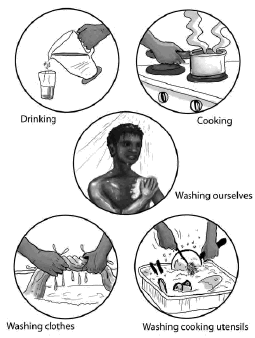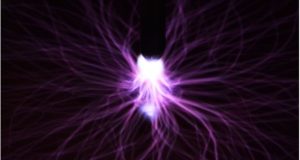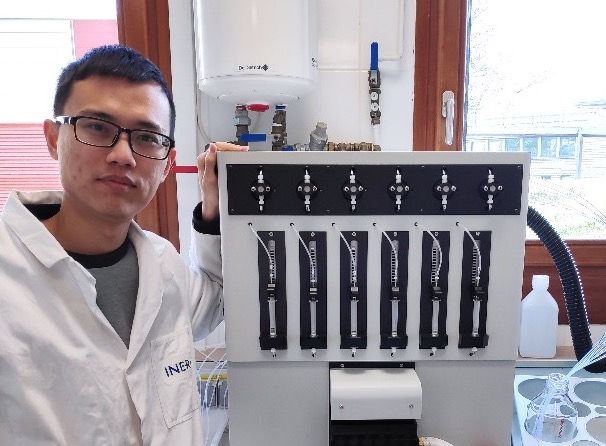I am Pham Quynh Khoa, being one of the early stage researchers of the InnovEOX project. The InnovEOX project, funded by the European Union, gathers researchers with a background in chemical engineering and analytical chemistry in academia and industry. The aim of this project is to develop advanced waste water treatment techniques that can protect our water sources from toxic micropollutants by eradicating them from water bodies. At this point, I am wondering myself why we must invest more and more money and keep constant effort in investigation of such techniques to protect water only. Therefore, I have tried to figure it out.

Water plays a vital role in life processes, being indispensable not only to animals and humans but also to plants on earth. In biology, water is the key component constituting the body structure, namely that water comprises from 75% of an infant, 67.85% of an adult to 55% of elderly by weight, while the essential organs of our body such as brain and heart are composed of water in 73.33% and 73.69% respectively, being essential for homeostatic and life processes (1,2). To be more specific, water is considered as a universal solvent in charge of transporting nutrients and oxygen to target organs to produce energy and simpler functional compounds such as glucose, amino acids and fatty acids, and carrying secondary compounds and carbonic acid from the organs to others of elimination to excrete them from body (3,4). Thanks to its unique behaviours, water takes on a key role in temperature and osmolarity regulation, acid-base balance, hormonal and renal management in human (2,3). Therefore, a little loss of total body water can threat life functions. Fatigue and dizziness were observed when a 5 – 8% of the total body water decreased. Over 10% loss can lead to physical and mental disorders or even death can occur if 15 – 25% of the total body water was lost (5). Apart from the essence of water to humans, water also makes a huge contribution to plant survival. Water dissolves nutrients in soil to form a supplemental solution, which is absorbed through root system to each plant cell, being a carrier to transport these essential compounds from one cell to another one in plant as well (6,7). Water is also one of the reactants in photosynthesis reaction producing carbohydrates and energy for plant’s survival activities and oxygen for humans and animals (7). Besides its survival contribution to life on earth, water is the essential need to satisfy human basic activities of cooking, bathing and washing (8). Also, water plays important role in promoting social and economic development such as breeding and cultivation, energy generation, construction and accommodation of climate change (8). These activities increase a family, a national income as well as ensure food and social security.
Most importantly, water used for these purposes is clean water that means that water must not contain microorganism, chemicals and be clear (8).



Water roles in survival activities of humans, animals and plants
However, according to United Nations Water, water pollution is a severe worldwide issue due to increased population, accelerated urbanization, and rapid industrialization, posing daunting challenges for all the countries, especially in low-income areas in developing nations where a large amount of waste water without treatment or treated very little is directly discharged into surface water (9). Consequently, toxic micropollutants encourage accelerated proliferation of phytoplankton in aquatic ecosystem that depletes oxygen and habitat of other creatures, leading to destruction of biodiversity (10). Furthermore, the toxic compounds are bio-accumulated in plants and animals through the use of polluted water in breeding and cultivation, resulting in introduction of toxic compounds into foods which threaten our health when eaten (10). Last but not least, the water scarcity is the biggest concern of many countries over the world where 80% of waste water with inadequate treatment flowing back to the ecosystem lead to serious situations in which approximately 1.8 billion people have no access to clean water and have to use faeces-contaminated drinking water (9). Poor water quality is associated with severe effects on human health such as diarrheal illness (11), typhoid fever (12), schistosomiasis due to the presence of harmful microorganism (13). For these above reasons, there is, therefore, no doubt that the development of advanced waste water treatment techniques is indispensable not only to protect scarce water sources but also to protect the survival of Earth.
References:
- Mitchell, H.; Hamilton, T.; Steggerda, F. R.; Bean, H. S., The chemical composition of the adult human body and its bearing on the biochemistry of growth. Journal of Biological Chemistry 1945, 158, 625-637.
- Popkin, B. M.; D’Anci, K. E.; Rosenberg, I. H., Water, hydration, and health. Nutr Rev 2010, 68 (8), 439-458.
- Riveros-Perez, E.; Riveros, R., Water in the human body: An anesthesiologist’s perspective on the connection between physicochemical properties of water and physiologic relevance. Annals of Medicine and Surgery 2018, 26, 1-8.
- Riebl, S. K.; Davy, B. M., The Hydration Equation: Update on Water Balance and Cognitive Performance. ACSMs Health Fit J 2013, 17 (6), 21-28.
- Ashcroft, F., Life Without Water in Life at the Extremes. HarperCollins Publishers Inc.: New York, 2000; p 134-138.
- Nieves-Cordones, M.; García-Sánchez, F.; Pérez-Pérez, J. G.; Colmenero-Flores, J. M.; Rubio, F.; Rosales, M. A., Coping With Water Shortage: An Update on the Role of K+, Cl-, and Water Membrane Transport Mechanisms on Drought Resistance. Frontiers in Plant Science 2019, 10 (1619).
- Andrew J. McElrone, B. C., Greg A. Gambetta, Craig R. Brodersen, Water Uptake and Transport in Vascular Plants. Nature Education Knowledge 2013, 4 (5), 6.
- Geoff Harcombe, S. H., Matthew Lester, Michael Lindsay, Donna Mak, Kylie Neaves, Danielle Philippe, Henry Tan, enHealth Working Group, Clayton Abreu, Garry Dunbar, Bronwyn Hill, Ken O’Donnell, Jenni Paradowski, Xavier Schobben, Brendon Sherratt, Brendan Ninness, Water Supply – Environmental Health Practitioner Manual: a resource manual for Environmental Health Practitioners working with Aboriginal and Torres Strait Islander Communities. Environmental Health Directorate of the Department of Health Western Australia: Australia, 2010; p 238-282.
- Water, U. N. Water Quality and Wastewater; https://www.unwater.org/water-facts/quality-and-wastewater-2/.
- Bashir, I.; Lone, F. A.; Bhat, R. A.; Mir, S. A.; Dar, Z. A.; Dar, S. A., Concerns and Threats of Contamination on Aquatic Ecosystems. In Bioremediation and Biotechnology: Sustainable Approaches to Pollution Degradation, Hakeem, K. R.; Bhat, R. A.; Qadri, H., Eds. Springer International Publishing: Cham, 2020; pp 1-26.
- Liu, L.; Johnson Hl Fau – Cousens, S.; Cousens S Fau – Perin, J.; Perin J Fau – Scott, S.; Scott S Fau – Lawn, J. E.; Lawn Je Fau – Rudan, I.; Rudan I Fau – Campbell, H.; Campbell H Fau – Cibulskis, R.; Cibulskis R Fau – Li, M.; Li M Fau – Mathers, C.; Mathers C Fau – Black, R. E.; Black, R. E., Global, regional, and national causes of child mortality: an updated systematic analysis for 2010 with time trends since 2000. (1474-547X (Electronic)).
- Bennett, S. D.; Lowther, S. A.; Chingoli, F.; Chilima, B.; Kabuluzi, S.; Ayers, T. L.; Warne, T. A.; Mintz, E., Assessment of water, sanitation and hygiene interventions in response to an outbreak of typhoid fever in Neno District, Malawi. PLoS One 2018, 13 (2), e0193348-e0193348.
- Esrey, S. A.; Potash Jb Fau – Roberts, L.; Roberts L Fau – Shiff, C.; Shiff, C., Effects of improved water supply and sanitation on ascariasis, diarrhoea, dracunculiasis, hookworm infection, schistosomiasis, and trachoma. (0042-9686 (Print)).

Quynh-Khoa Pham is a researcher in Pharmaceutical Analysis from Vietnam. Currently, he is a Marie Curie Early Stage Researcher (ESR09) of the InnovEOX project in which he is mainly working at Ineris in France under the supervision of Prof. Dr. Deirdre Cabooter at KU Leuven in Belgium and Dr. Francois Lestremau at Ineris in France.
 InnovEOX Innovative Electrochemical OXidation Processes for the Removal and Analysis of micro-pollutants in water streams
InnovEOX Innovative Electrochemical OXidation Processes for the Removal and Analysis of micro-pollutants in water streams



